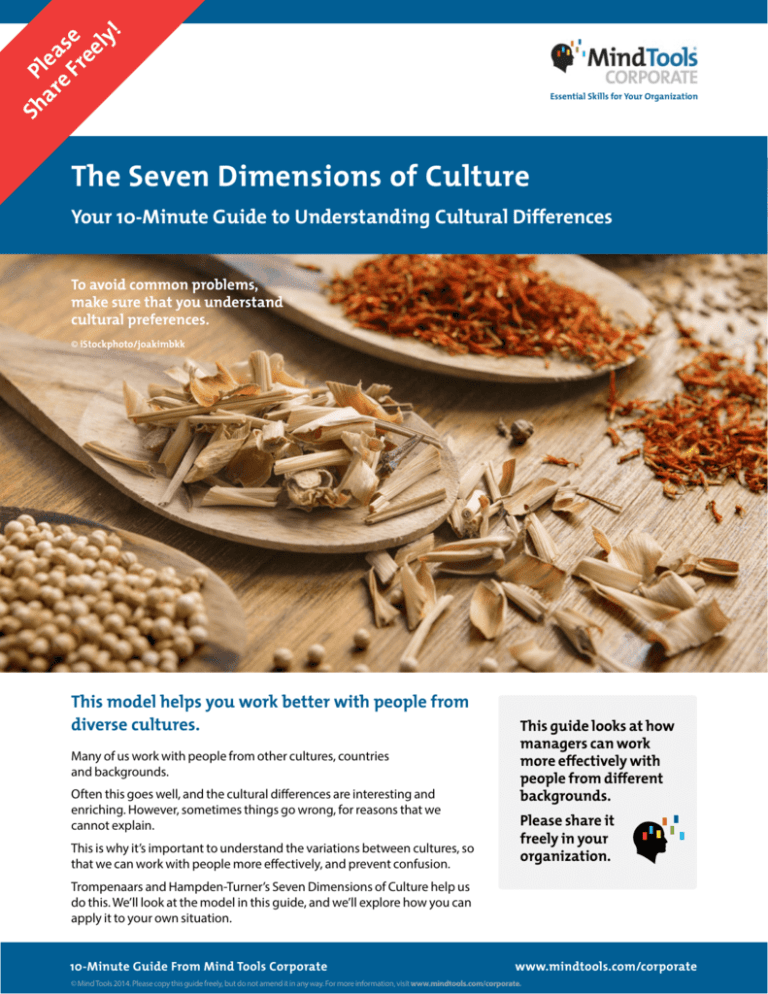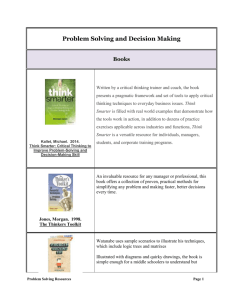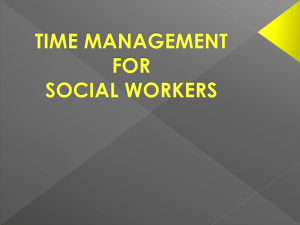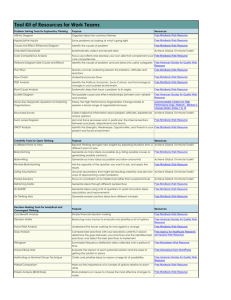The Seven Dimensions of Culture
advertisement

P ar lea e F se re el y! Sh Essential Skills for Your Organization The Seven Dimensions of Culture Your 10-Minute Guide to Understanding Cultural Differences To avoid common problems, make sure that you understand cultural preferences. © iStockphoto/joakimbkk This model helps you work better with people from diverse cultures. Many of us work with people from other cultures, countries and backgrounds. Often this goes well, and the cultural differences are interesting and enriching. However, sometimes things go wrong, for reasons that we cannot explain. This is why it’s important to understand the variations between cultures, so that we can work with people more effectively, and prevent confusion. This guide looks at how managers can work more effectively with people from different backgrounds. Please share it freely in your organization. Trompenaars and Hampden-Turner’s Seven Dimensions of Culture help us do this. We’ll look at the model in this guide, and we’ll explore how you can apply it to your own situation. 10-Minute Guide From Mind Tools Corporate www.mindtools.com/corporate © Mind Tools 2014. Please copy this guide freely, but do not amend it in any way. For more information, visit www.mindtools.com/corporate. Essential Skills for Your Organization About the Model Fons Trompenaars and Charles Hampden-Turner published the Seven Dimensions of Culture in their 1998 book, “Riding The Waves of Culture: Understanding Diversity in Global Business.” To develop the model, they spent 10 years researching the preferences and values of people in various cultures around the world. As part of this, they surveyed more than 46,000 managers in 40 countries. They found that people from different cultures vary in specific, even predictable, ways. This is because each culture has its own way of thinking, its own values and beliefs, and its own preferences. Trompenaars and Hampden-Turner concluded that what distinguishes people from different cultures is where these preferences fall on the following seven dimensions: 1. 2. 3. 4. 5. 6. 7. Universalism versus particularism. Individualism versus communitarianism. Specific versus diffuse. Neutral versus emotional. Achievement versus ascription. Sequential time versus synchronous time. Internal direction versus outer direction. From “Riding The Waves of Culture: Understanding Diversity in Global Business” by Fons Trompenaars and Charles Hampden-Turner. Published by McGraw Hill, 1998. We look at these dimensions in more detail in the tables below. You can use the model to learn about people from different cultural backgrounds, so that you prevent misunderstandings and enjoy a better working relationship with them. This is especially useful if you do business with people from around the world, or if you manage a diverse group of employees. It also highlights that one culture is not necessarily better or worse than another; people from different cultural backgrounds simply make different choices. The model doesn’t tell you how to measure people’s preferences on each dimension. Therefore, it’s best to use it as a general guide only. Applying the Model Let’s look at each of the dimensions in detail, and explore some of the strategies that you can use with people who fit the characteristics we highlight. Note 1: This model doesn’t take into account people’s personal experiences or differences between sub-cultures within a country, so bear this in mind when you apply it. This is especially relevant in today’s global environment, where people can be influenced by many different cultures. Note 2: Be sensible in how you apply these strategies. In practice, there will be many other factors that will have a bearing on how you should manage people and communicate with them. 1. Universalism Versus Particularism (Rules Versus Relationships) Dimension Characteristics Strategies Typical Cultures Universalism People place a high importance on laws, rules, values, and obligations. They try to deal fairly with people based on these guidelines, but rules come before relationships. • Help people understand how their work ties into their values and beliefs. • Provide clear instructions, processes and procedures. • Keep promises and be consistent. • Give people time to make decisions. • Use an objective process to make decisions, and explain your thinking if others are involved in the outcome. The U.S., Canada, the U.K, the Netherlands, Germany, Scandinavia, New Zealand, Australia, and Switzerland. 10-Minute Guide From Mind Tools Corporate www.mindtools.com/corporate © Mind Tools 2014. Please copy this guide freely, but do not amend it in any way. For more information, visit www.mindtools.com/corporate. Essential Skills for Your Organization Particularism People believe that their circumstances and relationships dictate the rules that they live by. Their response to a situation may change, based on what’s happening in the moment, and who’s involved. • Give people autonomy. • Respect others’ needs when you make decisions. • Be flexible in how you make decisions. • Take time to build relationships and get to know people so that you can understand their needs better. • Highlight important rules and policies that others must follow. Russia, Latin America and China. 2. Individualism Versus Communitarianism (the Individual Versus the Group) Dimension Characteristics Strategies Typical Cultures Individualism People believe in personal freedom and achievement. They believe that they must make their own decisions, and that they must take care of themselves. • Praise and reward individual performance. • Give employees autonomy to make their own decisions and to use their initiative. • Link people’s needs with those of the group or organization. • Allow them to be creative and to learn from their mistakes. The U.S., Canada, the U.K, Scandinavia, New Zealand, Australia, and Switzerland. Communitarianism People believe that the group is more important than the person, and that it provides help and safety in exchange for loyalty. The group always comes before the individual. • Praise and reward group performance. • Don’t praise individuals publicly. • Allow people to involve others in decision making. • Don’t show favoritism. Japan and countries in Latin America and Africa. 3. Specific Versus Diffuse (How far People get Involved) Dimension Characteristics Strategies Typical Cultures Specific People keep work and personal lives separate. As a result, they believe that relationships don’t have much of an impact on work objectives, and they believe that people can work together without getting along personally. • Be direct and to the point. • Focus on people’s objectives before you focus on strengthening relationships. • Provide clear instructions, processes and procedures. • Allow people to keep their work and home lives separate. The U.S., the U.K., Switzerland, Germany, Scandinavia, and the Netherlands. 10-Minute Guide From Mind Tools Corporate www.mindtools.com/corporate © Mind Tools 2014. Please copy this guide freely, but do not amend it in any way. For more information, visit www.mindtools.com/corporate. Essential Skills for Your Organization Diffuse Argentina, Spain, • Focus on building a good relationship People see overlap Russia, India, with people before you focus on between their work and and China. business objectives. personal life. They believe that good relationships are • Find out as much as you can about the people who you work with and the vital to meeting business organizations that you do business with. objectives. People • Be prepared to discuss business on social spend time outside work occasions, and to have personal discussions hours with colleagues at work. and clients. • Try to avoid turning down invitations to social functions. 4. Neutral Versus Emotional (How People Express Emotions) Dimension Characteristics Strategies Typical Cultures Neutral People make a great effort to control their emotions. Reason influences their actions far more than their feelings. They don’t reveal what they’re thinking or how they’re feeling. • Manage your emotions effectively. • Watch that your body language doesn’t convey negativity. • “Stick to the point” in meetings and interactions. • Watch people’s reactions carefully, as they may be reluctant to show their true emotions. The U.S., the U.K., Switzerland, Germany, Scandinavia, and the Netherlands. Emotional People find ways to express their emotions, even spontaneously, at work. In these cultures, it’s welcome and accepted to show emotion. • Open up to people to build trust and rapport. • Use emotion to communicate your objectives. • Learn to manage conflict effectively, before it becomes personal. • Use positive body language. • Have a good attitude. Argentina, Spain, Russia, India, and China. 5. Achievement Versus Ascription (How People View Status) Dimension Characteristics Strategies Achievement • Reward and recognize good People believe that you performance appropriately. are what you do, and • Use titles only when relevant. they base your worth accordingly. These cultures • Be a good role model. value performance, no matter who you are. Ascription People believe that you should be valued for who you are. Power, title and position matter in these cultures, and these roles define people’s behavior. Typical Cultures The U.S., Canada, Australia, and Scandinavia. • Use titles, especially when they clarify people’s status in an organization. • Show respect to those in authority, particularly when challenging decisions. • Don’t “show up” people in authority. 10-Minute Guide From Mind Tools Corporate France, Italy, Japan, and Saudi Arabia. www.mindtools.com/corporate © Mind Tools 2014. Please copy this guide freely, but do not amend it in any way. For more information, visit www.mindtools.com/corporate. Essential Skills for Your Organization 6. Sequential Time Versus Synchronous Time (How People Manage Time) Dimension Characteristics Strategies Typical Cultures Sequential Time • Focus on a few activities or projects at People like events to a time. happen in logical order. They place a high value on • Be punctual. punctuality, planning (and • Set clear deadlines, and stick to them. sticking to your plans), and staying on schedule. In this type of culture, “time is money,” and people don’t appreciate it when their schedule is thrown off. Germany, the U.K. and the U.S. Synchronous Time People see the past, present and future as interwoven periods. They often work on several projects at once, and view plans and commitments as moveable. • Be flexible in how you approach work, and allow others to do the same. • Highlight the importance of punctuality and deadlines if these are key to meeting objectives. Japan, Argentina and Mexico. 7. Internal Direction Versus Outer Direction (How People Relate to Their Environment) Dimension Characteristics Strategies Typical Cultures Internal Direction People believe that they can control their environment to achieve their goals. This includes how they work with teams and within organizations. • Allow others to develop their skills and take control of their learning. • Set clear objectives that people agree with. • Be open about disagreements, and allow people to engage in constructive conflict. Israel, the U.S., Australia, New Zealand, and the U.K. Outer Direction People believe that nature, • Provide people with the support and resources to do their jobs effectively. or their environment, controls them. At work and • Give them direction and regular feedback, so that they know the results of in relationships, they focus their actions. their actions on others, • Reassure people that they’re doing a and they avoid conflict good job. where possible. • Manage conflict quickly and quietly. • Do whatever you can to boost people’s confidence. • Encourage others to take responsibility for their work. 10-Minute Guide From Mind Tools Corporate China, Russia and Saudi Arabia. www.mindtools.com/corporate © Mind Tools 2014. Please copy this guide freely, but do not amend it in any way. For more information, visit www.mindtools.com/corporate. Essential Skills for Your Organization Key Points The Seven Dimensions of Culture model was created by Fons Trompenaars and Charles Hampden-Turner, and was published in their 1998 book, "Riding The Waves of Culture: Understanding Diversity in Global Business." The model says that what distinguishes people from different cultures is where their preferences fall in these seven dimensions: • • • Universalism versus particularism. Individualism versus communitarianism. Specific versus diffuse. • • • • Neutral versus emotional. Achievement versus ascription. Sequential time versus synchronous time. Internal direction versus outer direction. You can use the model to understand people from different cultural backgrounds better, so that you can work with them more effectively. Be sensible in how you apply the model. Treat people as individuals, and remember that there are many factors that will have a bearing on how you should communicate and interact with them. Visit www.mindtools.com/corporate to find out how your organization can access more than 1000 articles on leadership, management, problem solving, and communication. You can also license more than 60 one-hour training courses and hundreds of business podcasts. Used together, these resources help develop and embed skills organization-wide. 10-Minute Guide From Mind Tools Corporate www.mindtools.com/corporate © Mind Tools 2014. Please copy this guide freely, but do not amend it in any way. For more information, visit www.mindtools.com/corporate.









